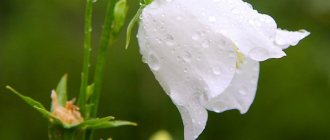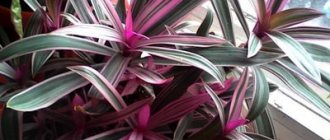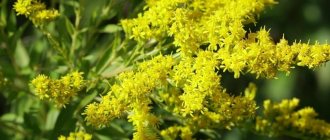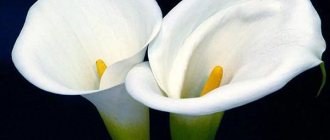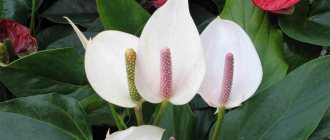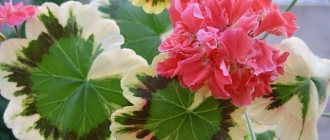Unrelated flowers similar to lilies - order Asparagusaceae
Of course, there are flowers in the world that look like lilies, not from the Liliaceae order, and we have prepared for you some plants with photos and names.
We have chosen families, among which there are beautiful and unusual flowers.
Hesperocalisaceae . Hesperocallis is a lily-like flower on a thick stem.
Hesperocallis - a desert inhabitant with a beautiful flower
.
Ixiolirionaceae
Ixiolirion Tatarian - amazing beauty!
.
Among the Irisaceae , in addition to the familiar iris (“cockerel”), Watsonia can be distinguished.
Watsonia
.
Xanthorrhoeae family deserves special attention thanks to the genus Daylily. Various types of daylilies are very popular among our gardeners and are highly decorative.
At the moment, there are a great many varieties of daylilies with flowers of different colors.
Yellow daylily (Hemerocállis lílioasphodélus) also known as yellow lily or red lily
.
Among the Prolesaceae , hyacinths are very similar to lilies.
Especially for lovers of lilies with small flowers, we recommend growing oriental hyacinth. Flowers similar to small lilies are not difficult to care for and grow.
- Oriental hyacinth is highly decorative with a strong and at the same time pleasant aroma.
Hyacinth is suitable for growing in winter and cutting for bouquets, and is also one of the most popular house flowers.
There are more than 300 varieties of hyacinth with different colors: white (Inosans), pink (Pint Pearl), blue (Miosotis) and red (Jean Beauce). Hyacinth blooms for about 12-16 days.
This flower is similar to small lilies, usually 15-25 cm in height with shiny and succulent leaves. The flowers themselves are bell-shaped in cylindrical inflorescences.
Black hyacinth
.
Amaryllis family: champion among lily-like flowers
The amaryllis family includes more than 60 genera, of which there are a large number of flowers resembling lilies.
AMARILLIS AND HIPPEASTRUM
We have separated these two genera, as flower growers often confuse them. Amaryllis and hippeastrum are similar in appearance, have large bulbs and thick peduncles with “umbrellas”.
According to the official classification, the Amaryllis genus includes one species - Amaryllis belladonna. Amaryllis belladonna is a rather rare plant and is not widely distributed among domestic flower growers.
Much more often you can find hippeastrum, which some sellers knowingly or unknowingly sell under the guise of “amaryllis”. Hippeastrum is well suited for growing as a potted crop and for cutting.
Lily-like flowers on a thick stem
Garden lilies have flower stalks that are not too thick, but strong. In other plants they are very thick and juicy.
Cardiocrinum or giant lily
What are the names of flowers that look like daisies?
Translated, the name cardiocrinum (lat. Cardiocrínum) means heart-shaped lily. It’s hard to believe that a plant up to 4 m high dies almost immediately after flowering. Notable are the flower stalks, which, like tree trunks, can reach 15 cm in diameter.
Interesting! Up to 80 buds can bloom on a peduncle at the same time - a gigantic bouquet!
In garden culture, very diverse varieties of cardiocrinum are grown, which differ in height, flowering time, and shades of petals (Chinese, Yunnan and others). A tall stem grows from the bulb, ending in a peduncle, and closer to the ground it bears large heart-shaped green leaves. Each flower is very elongated, consists of 6 petals up to 18 cm long.
heart lily
Amaryllis
This flower is grown in gardens in southern countries, and in Russia it has found popularity in potted culture. A perennial bulbous plant native to South Africa. Amaryllis (lat. Amaryllis) from its large pear-shaped bulb (up to 12 cm in diameter) expels a thick peduncle (up to 70 cm), ending in several buds, and in the lower part there are only a few narrow juicy straight leaves of dark green color.
Sometimes the bulbs produce 3 stems, at the end of each of which there can be 4-12 buds. The diameter of the flower, consisting of 6 outwardly curved petals, is usually about 10 cm, but there are also larger varieties. There are all kinds of colors: white, red, purple, pink, etc., but there is no orange. Flowering occurs only once a year.
Amaryllis blooms on the windowsill in winter
Hippeastrum
Beginners often confuse it with amaryllis, with which hippeastrum (lat. Hippeastrum) belongs to the same family. The genus includes about 90 species, differing in size and color. The bulb grows up to 10 cm in diameter. Linear leaves up to 70 cm long are green and purple.
Interesting! The plant is popularly called the “house lily.”
The peduncle is 35-80 cm long, hollow inside, and bears an umbrella inflorescence of 2-6 bisexual flowers up to 25 cm in diameter each. The buds grow on their own long stalks. The color of the petals is even more varied than that of amaryllis; it can be bicolored or spotted. It takes an average of 18-20 months for each peduncle to fully grow and bloom indoors.
Hippeastrum
Red flowers similar to lily: amaryllis, hippeastrum and wallotha
As we have already said, amaryllis is represented by one species. This red lily-like flower is native to South Africa and grows to 50-70 cm in height.
Amaryllis belladonna has excellent decorative qualities, a very beautiful and bright flower.
Bright red amaryllis in a chic bouquet.
It is worth noting that there are garden forms not only with red flowers, but also with pink (Amaryllis belladonna major), light pink (Amaryllis belladonna minor).
HIPPEASTRUM
As mentioned above, amaryllis and hippeastrum are very similar to each other, and at the same time similar to lilies. Hippeastrum has beautiful large flowers.
The genus includes more than 75 plant species, which mainly grow in the tropical and subtropical climate zones of America.
- With the development of floriculture, many garden forms appeared. Hybrid varieties of hippeastrum are distinguished by a variety of colors.
Hippeastrums in red, orange, pink, white and purple colors are widely found.
Blooming hippeastrum
WALLOTA IS BEAUTIFUL
The Wallota flower is native to Africa and is a relative of the amaryllis. The plant has a smaller bulb size and narrower and longer leaves.
Flowers are mainly found in red shades, sometimes white and pink. Wallot is an unpretentious plant and easy to care for.
- For abundant flowering in summer, neither a cramped pot, a cold room, nor dry soil in winter will interfere with it. It grows very quickly so that you definitely won’t have a shortage of flowers.
When the children are separated from the mother bulb, the number of flowers increases even more. Small valottas bloom in the second year.
This indoor flower is similar to a lily in the shape of its inflorescences and gives no less positive emotions.
In summer, the plant loves light and water; it is not demanding on the soil. Ideally, grow in a mixture of turf and deciduous soil with river sand and humus. In winter, the main thing is to provide moderate watering; the flower can withstand up to +5-7 degrees.
Vallota the Beautiful
Vallota, hippeastrum, amaryllis and clivia: how to distinguish and grow?
So, we have 4 plants and they are all very similar to each other. And all because they are closest relatives and belong to the same Amaryllis family. This means they have common character traits, i.e. buildings.
- Common features of all representatives of Amaryllis
- How to distinguish hippeastrum, amaryllis, valota and clivia?
- Conditions for growing Amaryllis
Common features of all representatives of Amaryllis
The stem of Amaryllidaceae is a leafless peduncle , round or flattened in cross section. The flowers of all Amaryllis are very beautiful and are collected in inflorescences, which are more or less pronounced umbrellas. Flowers, with rare exceptions, are bisexual, drooping, curved or erect, usually with bright, saturated colors (red, pink, white, yellow): spots and stripes are often found on the perianth segments. Another distinctive feature of Amaryllis is a strong, pronounced aroma in many species, but this is not the case, for example, in hippeastrums.
The leaves of Amaryllis representatives contain a lot of alkaloid mucus, as, indeed, in other parts of plants of this family. Most Amaryllidaceae are poisonous.
How to distinguish hippeastrum, amaryllis, valota and clivia?
Based on the first and most striking feature, we will divide them into 2 groups: the first will include hippeastrum and amaryllis, the second - wallota and clivia. And this sign is the size of the flower (and let the botanists kick us after that).
The average size of hippeastrum and amaryllis flowers is 10 cm (as we were corrected in the comments, there are indeed varieties of hippeastrum with a flower diameter of less than 10 cm, these are Solo - 6 cm or less and Sonatini - 6-10 cm, but more often in sale, there are precisely large-flowered varieties), but there are flowers with a diameter of up to 18-22 cm . The inflorescence itself consists of one to six large flowers. In this respect, hippeastrum and amaryllis are similar. But they differ from each other in the structure of the peduncle : hippeastrum has a hollow peduncle, while amaryllis does not.
It is believed that amaryllis bloom in a leafless state, and hippeastrums - leafy, but this is not always the case. In addition, hippeastrum flowers are not fragrant, unlike amaryllis flowers.
Hippeastrum and amaryllis
The flowers of wallot and clivia are smaller, they reach a diameter of 4 to 7-10 cm . There are up to 20 medium-sized flowers on the peduncle. This is how they are similar, but they differ in that clivia has thick rhizomes, and volata has a brownish, elongated, ovoid bulb, reddish in the upper part. And the wallot reproduces by baby onions.
Vallota
The flowers themselves are usually red, with a maximum of 4-5 on a peduncle, while in clivia they are smaller, orange with a yellow center, BUT 10-20 per peduncle. BUT, the most important thing is that clivia juice is orange. So if a leaf on your plant accidentally breaks off and you see orange juice, then it’s a clivia. But you don’t have to break the leaves; it’s easier to dig up the pot a little and look at the roots or the bulb.
Clivia
In addition to the above flowers, the Amaryllidaceae family of indoor flowers includes - crinum, eucharis, hemanthus, nerine, zephyranthes, sprekelia , vorsleya (blue amaryllis) and from garden ones - snowdrop and onion .
Other representatives of Amaryllidaceae: Crinum, Nerine, Sprekelia and Zephyranthes
Conditions for growing Amaryllis
The growing requirements for all these flowers are approximately the same: keep them light in summer, but without direct sunlight. Watering in summer is abundant (eucharis) and moderate (most) and in winter (dormant period) from moderate to rare. Transplantation - in the spring. And of course, to maintain the appearance, it is advisable to trim off faded flower stalks.
See the most beautiful varieties of hippeastrum here >>>


